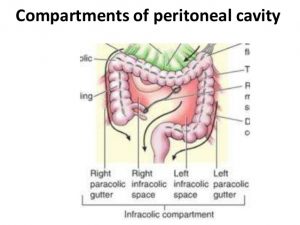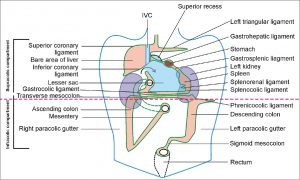What is paracolic gutter?
Etiologically it means a channel adjacent to the abdominal wall. Between the outer wall of the colon and back side of the abdominal wall, there is an open space known as the paracolic gutter. It is also known as sulci paracolic and paracolic recesses. It is the depression between the postero-lateral wall of the abdomen and the lateral margins of the ascending and descending colon.
Paracolic Gutter Location
There are two paracolic gutters in a human body:
- The left lateral paracolic gutter
- The right lateral paracolic gutter
The right and left paracolic gutters both lies on the lateral side of posterior abdominal wall alongside the ascending and descending colon, are the peritoneal recesses. The right paracolic gutter is much larger than the left one and thus allows more fluid to pass through.
Paracolic Gutter Structure
The right lateral paracolic gutter runs along the right side of the cavity of the abdomen. Its origin lies on the right side origin of the right paracolic gutter lies at the ascending portion of the colon at the right hepatic flexure or the point where the ascending colon turns at a right angle to form the transverse colon. This gutter is continuous with perisplenic space around the spleen. At the distal end, it continues up to the caecum or terminal ileum i.e., the junction between the caecum and ileum.
The left lateral paracolic gutter is on the left side of the abdominal cavity between the outer wall of the descending colon and posterior abdominal wall. Similar to its right counterpart the paracolic gutter originates from the left hepatic flexure or the meet point of the transverse and descending colon and runs downward to empty into the pelvic region or abdominal wall. Restricted at the top by the phrenicocolic ligament that supports the top left edge of the colon, the left lateral gutter is comparatively much smaller than the right one. The presence of this ligament prevents the left gutter to be continuous with the pherisplenic space.
These gutters along with their cousins left and right perimesenteric gutters form the four major open spaces if the abdominal cavity. Sometimes in rare cases, a medial paracolic gutter is formed which is more to the right side of the abdominal cavity. A medial gutter is formed when part of the length of the colon there is a short mesentery.
Paracolic Gutter Pictures
Paracolic Gutter Function
These gutters play a significant role in the proper functioning of the body. The infectious fluids from the different compartment of the abdominal cavity that leaks from the colon gets a passage through the paracolic gutters. In this way, further chances of infection are reduced and the hygiene of outer wall of the colon is also maintained. For example,
- Fluid from affected peritoneum caused by bacterial or fungal infection due to abdominal injury or from a septic treatment device like catheter dialysis passes down the paracolic gutters and open to the pelvic region.
- Infectious fluids due to appendicitis (caused by the bacterial attack to the wall of the appendix) are drained out
Paracolic Gutter Clinical significance
Intra-abdominal abscess
When a pus (a green or yellow colored fluid containing dead WBC, bacteria, debris of tissue and serum) gets accumulated leading the body tissues of the area to swollen up, is known as abscess and the process is known as abscission.
Cause and mechanism
Following an abdominal injury or disease, when the immunity is weak the peritoneal cavity is affected by microorganisms which stimulate the body to the response against the foreign bodies accompanied the release of several inflammatory cells to the body. With the release of the inflammatory cells the peritoneum, walls of the abdomen and omentum get activated to localize the infection so that it does not spread to other organs by walling it off. Although this natural immune system temporarily supports the body to prevent further complication, soon anaerobic bacterial development starts at the walled of the infected site as the site lacks oxygen. This accumulation of bacteria or other microorganisms lead to enlargement of abscess cells.
Involvement of the gutter
The paracolic gutter is associated with a subphrenic abscess. The right and left paracolic gutter are connected to subphrenic spaces proximally and to the pelvic area at the distal end. Infected peritoneal fluids get a passageway through these gutters to other compartments of the abdominal cavity. The presence of the gutters also puts the lesser sac at risk of abscission, as infected fluids from pancreas and appendix formed due to pancreatitis and appendicitis respectively will accumulate in the left sac. The paracolic gutters have exposed the retro-visceral pouch and retro-uterine pouch (or, pouch of Douglas) in the pelvic cavity of men and women to infected fluids, blood and pus from abdominal and pelvic organs.
Symptoms
The abdominal abscission shows vague symptoms which are generally ignored or looked upon. But one who has a recent major abdominal surgery, have diabetes or patients with inflammatory bowel disease must be aware and look out for the signs of the disease like-
- Radiating pain with epicenter at belly and spreading to chest and shoulders.
- Fever, nausea, and vomiting
- Loss of appetite leading to malnourishment
- Mass in the abdomen
- Rectal tenderness or fullness
Diagnosis
While the symptoms are not much differentiating, a medical professional may raise a doubt if he gets handy with your medical history. A doctor may take the following tests to diagnose an abdominal abscission-
- The primary diagnosis is a test for fever and a trained or experienced physician will identify a tenderness in the belly or feel a mass in the midsection.
- Blood tests like white blood cell (WBC) count or C-reactive protein (CRP) test which is an indicator test of the amount of inflammation.
- Imaging tests of belly like computerized tomography (CT) scan, ultrasound or magnetic resonance imaging (MRI).
Treatment
- If there is any abdominal infection, antibiotics will prevent abscission.
- However, if abscission has already be formed, the infected fluid must be drained of either by percutaneous disease (in preliminary stage) or by surgery (in more critical conditions).
Paracolic gutter FAQs
Are there any chances of malignancy in the paracolic gutter?
Although not much clinical history is found in this respect the chances cannot be ignored. Since the blockage of the gutter is rare, malignancy may occur to other organs or free abdominal spaces to which the paracolic gutters are associated.
Is there any chance of reverse flow of the infected fluids along the gutter?
In the case of infections in patients who are laid down to bed, there are chances of reverse flow. For e.g., infections due to appendicitis may flow in the reverse direction to the peritoneal cavity.
What increases chances of an intra-abdominal abscess?
Inflammation of tissues of abdominal organs increases the chances of intra-abdominal abscess.
References:
http://m.wisegeek.com/what-are-the-paracolic-gutters.htm
http://medical-dictionary.thefreedictionary.com/paracolic+gutters
https://www.kenhub.com/en/library/anatomy/anatomical-spaces-of-the-abdominal-cavity-part-ii&grqid=C8_SAPrq&hl=en-IN
http://www.hopkinsmedicine.org/healthlibrary/conditions/surgical_care/intra-abdominal_abscess_134,145/




No comments yet.